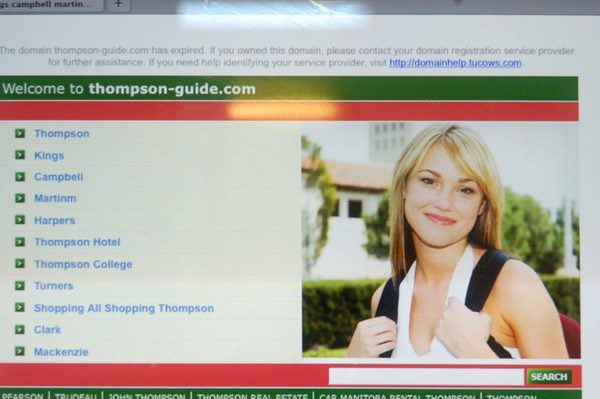What was originally planned two years ago as a one-stop shop where social workers, addictions counsellors, housing resource staff - and someone's granny logging on at a public computer terminal or at home - could find out online what resources related to dealing with drug issues are available in Thompson, but instead went online as a very general community resource guide, is defunct and offline.
The website - Thompson Guide to Community Resources at http://www.thompson-guide.com - was built, along with an earlier printed directory, through $101,468 in anti-drug strategy funding under the Drug Strategy Community Initiatives Fund (DSCIF) of the National Anti-Drug Strategy, announced in Winnipeg in 2007 by Prime Minster Stephen Harper.
Federal funding for the project expired as scheduled last April.
What the federal government does have to show for their investment almost three years ago is a community resource centre "which is up and running" at the Thompson branch of the Canadian Mental Health Association at 43 Fox Bay, said new executive director Paullette Simkins Feb. 4.
Called the "Community Resource and Information Centre," it now advertises regularly, urging people to "take advantage of the FREE advertisement and promote your business or organization by dropping off your information today."
"I have been made aware of the website which came with many problems when it was passed on - we're in the process of finding [an] alternative," Simkins said.
"The website was funded by that program (the Drug Strategy Community Initiatives Fund (DSCIF) which has now drawn to a close, thus there are no longer any funds - we are however in the process of adding the programs to our CMHA website."
The money for the Thompson project was channelled through the Nanatowiho-Wikamik Homeless Shelter, also known as the Thompson Homeless Shelter, and Michelle Mossip, who worked at the homeless shelter, oversaw the six-month web portion of the project.
John Donovan, Northern regional director of the Addictions Foundation of Manitoba (AFM), said in November 2007, he hoped that in practice the funding meant initially the development of the printed directory and an up-to-date dynamic website for Internet users looking for drug-related information in Thompson.
It never worked out that way.
From day one, the Thompson Guide to Community Resources website brought together in one place information already easily available and a few clicks away through either the Thompson.ca website, links found on the main Government of Manitoba website, or a basic Google search engine enquiry.
And from day one, there were myriad problems with the website. Back in April 2008, some e-mail addresses on the Thompson Guide to Community Resources website were already out of date or a mélange of an e-mail address and a web page address all lumped together as an e-mail address that bounced back to the sender.
Click on the Thompson Guide to Community Resources link for North Central Community Futures Development Corporation back then, and you would be taken not to their website but rather to the federal government website for Western Economic Diversification Canada.
The actual website design for the Thompson Guide to Community Resources was done by a home-based company called Web Estates at 7 Trout Ave. in Thompson, owned by V. G. Riauka. Other local Web Estate clients at the time included Skate Thompson, Jeff Fountain's Eight Dragon Kings Budokan and a site for Tammy Lee Marche, owner of BullMarket Consulting.
Some of the incorrect e-mail addresses and outdated organizational basic contact information were fixed after a Thompson Citizen story on the Thompson Guide to Community Resources appeared on April 23, 2008.
Donovan said Feb. 7: "The project began late with a worker [not Michelle Mossip, ed.] in City Hall doing outreach and organizing the hard copy of a directory. He left due to ill health and again a lapse in staffing."
The Nanatowiho-Wikamik homeless shelter was the lead agency on it because the federal funds must flow through a not-for-profit organization, Donovan said.
"The worker was then placed in the homeless shelter and began the work on the website," Donovan said. "It was established and she did training in about six agencies on the use and availability. Also agencies were invited to post events and training opportunities.
"Tammy Lee Marche of BullMarket Consulting did the initial survey of the website value. The worker left the position shortly after CMHA took over the shelter management and related projects."
Once the CMHA took over the shelter management contract, Donovan said, "Tammy Watson took the position and expanded the project to include an inter-agency resource centre to bring collective services to a one stop shop for information and pamphlets etc."
In fact, the CHMA-based resource centre didn't open until last Aug. 28. The CMHA had been managing the homeless shelter since January 2009 - eight months earlier. Watson, innovation and special initiatives co-ordinator, left the CMHA Sept. 18, 2009 and is now working as a civilian in Afghanistan in support operations for the Canadian Forces in Kandahar.
"I looked into it and we decided there's nowhere in the community that not only just new people but even people that live here can go and find out what actually is available in town," Watson said last August, saying often people are sent to many different places before they find the information they're looking for. "Here we're trying to just centralize it, and we're focusing mainly on social service agencies."
The community resource and information centre will also post information about agencies that are in need of volunteers or board members, she said. Watson also worked on gathering a few books to form a small library in the centre that will focus on social issues like illness and addiction.
Watson said she had been working on opening up the centre since February 2009. Originally, she said, it was going to involve information about businesses and schools, but she decided there were enough places in town to get information about those facilities but not enough about social and educational services, so the focus was put on them.
"I don't think people really understand what it is yet, and I think when they know how it's going to be utilized, it's going to be easier," she explains. "A few people have phoned and asked us about it and they think it's a good opportunity."
Watson said she hoped agencies throughout Thompson would bring their information to the CMHA so that it can be posted at the centre, saying it will benefit them as well as people in the community.
As for the website, Donovan said: "The website maintainer/designer moved to Waterloo and the site contract lapsed [the domain name thompson-guide.com is for sale] and no one to pick up the pieces. I was not aware this happened until recently when it was all down."
After Watson left last September, the CMHA had a part-time worker "who closed out the project," Donovan said. "Tammy is doing the final evaluation and CMHA is carrying on some of the resource activities under their umbrella."
The National-Anti-Drug Strategy was to provide $63.8 million over two years from 2007 to 2009 to prevent illicit drug use; treating those with illicit drug dependencies; and combating the production and distribution of illicit drugs.
Rather than the printed directory and up-to-date dynamic website for Internet users looking for drug-related information in Thompson that Donovan envisioned, in reality the project wound up looking closer to how Tory MP Steven Fletcher, from the riding of Charleswood-St. James-Assiniboia, described the project in 2007, saying the money was going "towards the development of a community resource outreach centre."
Donovan, however, had noted at the time the spectrum of potential users was quite large as drug issues impact on individuals and the community in myriad ways from obvious addiction issues right through to employment, childcare and housing.
The first phase of the project, which ended in September 2007, was the compilation of the printed resource handbook. That was the work done at City Hall.While the 60-odd page printed handbook was useful for about 20 agencies in town that initially required one, Donovan predicted it would quickly get out of date as a static document. "But that sort of thing can be changed quickly on a website."



